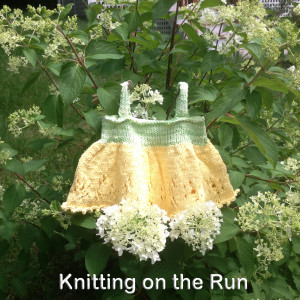
Episode 20 – 8/23/17
There might not be a show next week – it’s Thing 1’s last week before Kindergarten starts so we’re planning lots of fun stuff to end the summer. But I’ll definitely be back the following week.
FOs
Empire Top by Lily Go in discontinued bamboo/cotton blend, Picoboo by Frogtree
Wips
Triyang Shawl by Le Meredith in Yumbrel Araucania
Hitchhiker for my MIL in Kinu by Ito yarns, 100% silk
Cast on Second Grace by Bristol Ivy (first Bristol Ivy pattern) using Berroco Modern Cotton, then ripped it out to go down a needle size for the ribbing, and started casting it on again. I’m about half way through a cast on.
Wearables
Thoughts by Joji Locatelli on Araucania Yumbrel, a discontinued cotton lace-weight yarn
Today’s Discussion: There are No Knitting Police
Some people are really hesitant to change something and are fearful that they are doing it “wrong” but I want to assure you there are no knitting police. When you’re knitting from a pattern you do NOT have to do it exactly as written, you do NOT have to use the same yarn. Do you have a long torso? Add some extra rows. Short torso? Feel free to skip a few. Do you like your bum covered but the pattern doesn’t seem to work well in that area? Add some short rows in the back to cover your derriere. Love the body of the sweater but hate the sleeves? That’s fine, you could find a new pattern or just knit them in stockinette. Switch up the yarns (I’ll be doing a whole podcast on this in a future episode). My point is, once you purchase a pattern, it’s yours to alter as you please for your own sweater. I am NOT saying you should tweak the pattern and publish it – that’s a copyright violation. But tweak the pattern to fit your body and your knitting style. Here’s an example – I hate inserting sleeves after the fact, I can never get them to line up properly. So I don’t. I look at the sleeve pattern, reverse the pattern, then pick up and knit stitches around the arm hole and work all my sleeves that way, no matter what the pattern says.
On the Run
I’ve been running the past few weeks but haven’t mentioned it because the knitting segments have been running long. But this is the “Knitting On The Run” podcast after all so it’s time to get back on track. I’ve been injured basically since right after this podcast started, so over the next few weeks I want to talk about some injury issues and injury prevention. Even if you don’t run you might learn something that could help you, particularly if you’re dealing with chronic pain in your knees or hips for example.
First off – disclosure, I am not a medical professional. I am only someone who has gotten injured a lot and has had to learn a lot the hard way. If you are in pain, please consult a doctor or specialist.
That being said, today let’s talk quickly about body mechanics and injuries. When you’re running you are putting stress on your body, particularly your lower body. That’s a good thing, it keeps you in shape and your body is designed to move, not sit. You run into problems (and injuries) when something is off. If you have a mechanical issue, say in your foot or hips, the rest of your lower body, aka kinetic chain has to compensate. (linking to the American Academy or Orthopedic Surgeons to learn more). Over time the muscles, tendons and ligaments doing the compensating have too much stress on them and that’s where you get an injury. So the CAUSE of your injury isn’t necessarily where your injury APPEARS. That is why cross training and strength training is soooo important – you use your muscles different ways and strengthen the weak muscles.
Real world example – hip flexors (group of muscles/tendons/etc in front of your hips that you use to lift your legs. If they are really tight then they pull on your hamstrings so your hamstrings are always stretched and rarely relax. You’ll eventually end up with a pulled hamstring, but the cause isn’t the hamstring, it’s the hip flexors. Your hamstring is where the kinetic chain broke down
More Episodes
 2023-10-04
2023-10-04
 2023-09-20
2023-09-20
 2023-09-07
2023-09-07
 2023-08-02
2023-08-02
 2023-07-18
2023-07-18
 2023-06-29
2023-06-29
 2023-06-05
2023-06-05
 2023-04-30
2023-04-30
 2023-04-18
2023-04-18
 2023-04-04
2023-04-04
 2023-03-16
2023-03-16
 2023-03-01
2023-03-01
 2022-06-10
2022-06-10
 2022-05-21
2022-05-21
 2022-05-15
2022-05-15
 2022-05-09
2022-05-09
 2022-04-12
2022-04-12
 2022-03-25
2022-03-25
 2022-03-13
2022-03-13
 2022-03-07
2022-03-07
Create your
podcast in
minutes
- Full-featured podcast site
- Unlimited storage and bandwidth
- Comprehensive podcast stats
- Distribute to Apple Podcasts, Spotify, and more
- Make money with your podcast
It is Free
- Privacy Policy
- Cookie Policy
- Terms of Use
- Consent Preferences
- Copyright © 2015-2024 Podbean.com





